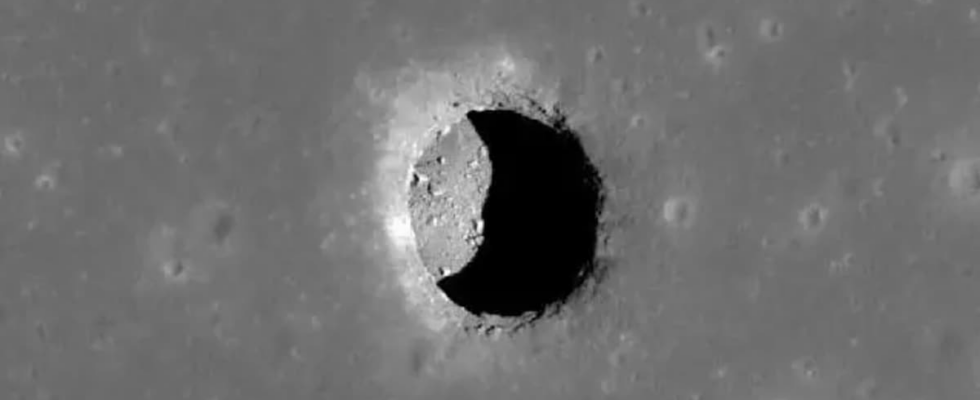Not far from where humans first landed on the moon, there is a large, oval hole in the ground. The pictures only show that the hole has a diameter of about one hundred meters and a depth of about 130 meters. What the researchers describe in an article in Nature Astronomy is a fork under the ground. That is, a cave that extends away from the hole. In that cave, humans can create safe bases, well protected from the radiation on the surface. DANGEROUS ON THE SURFACE: An imaginary lunar base. All buildings are well protected by thick layers of lunar material. This is to protect against both radiation and meteors. Photo: ESA Used old data The evidence indicating that there is a cave under the ground has been open since 2010. Then the American satellite Lunar Reconnaissance Orbiter shone a light on the hole with radar. What was reflected back by the radar signal shows that some of it had spread away from the hole and further underground before being ejected again, the researchers believe. THE PROOF: The studies show that there is an open structure at the bottom of the hole. Photo: Leonardo et.al/Nature – We are sure that there is a cave there, but the radar data gives us two different solutions to how it is designed, says one of the article’s authors, geologist Francesco Sauro from the European Space Agency ESA. VOLCANIC CAVES: Astronauts from the European Space Agency train with instructors from the Pangea program in Lanzarote. Photo: ESA Lava tunnels It is not a controversial claim. For many years, scientists have been fairly certain that such caves exist on the moon. So ensure that European astronauts are trained to move in such caves. – Such formations are made of lava, says geologist at the Norwegian Mining Museum, Kåre Kullerud. He has helped train the European astronauts. It happened in Lofoten. The European Space Agency ESA has a program to train astronauts to become field geologists. It’s called Pangea, and Kullerud is one of the instructors. NORWEGIAN GEOLOGY: Kåre Kullerud in the middle of the picture. He tells astronauts from ESA about the geology of Lofoten. Photo: Sirio Sechi / ESA – A human walking on the moon will be able to perceive details and the connection in the geology better than researchers who get information from robots, believes Kullerud. Many of them – There are hundreds of these pits that have been formed by volcanic activity on the moon, says the Italian geologist Sauro. He believes similar radar observations will reveal that many of them are linked to caves under the ground. – Then we can find one that is not as deep as the one we describe. Then it will be easier for people to explore them. Maybe there is a cave that only astronauts can enter, Sauro hopes. Francesco Sauro on the left in the picture and the Italian astronaut Samantha Cristoforetti in the middle. The picture taken in Lofoten. Photo: ESA / Vittorio Crobu Difficult, but easy Sauro has extensive experience in exploring such lava tunnels here on Earth. He is one of the instructors in the Pangea program. – On the moon, the gravity is only one sixth of the Earth’s gravity. It makes some operations such as climbing easier. It is still difficult, because you have to wear a rather rigid space suit, says Sauro. NOT SO EASY: One of the design proposals for a moon suit that could be used by the European astronauts. Photo: ESA/Oussama Guarraz The plan is to first find a suitable cave and then use robots to investigate it. Then humans can follow to do more thorough studies. – Under the ground there is material that has not been bombarded by radiation and meteorites for several billion years. So the samples we retrieve from this depth will be able to tell us more about how the moon was formed, says Sauro. MAYBE ONE LIKE THIS: One of the proposals for a European robot that can explore the moon and the planet Mars. Photo: ESA/ETH – It is the important research. Building a base there is of course an exciting possibility, but it will be a long way off, says the geologist. Published 16.07.2024, at 18.54
ttn-69
The researchers believe they have found a cave on the moon – news Urix – Foreign news and documentaries

